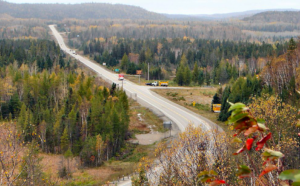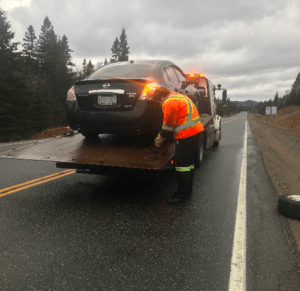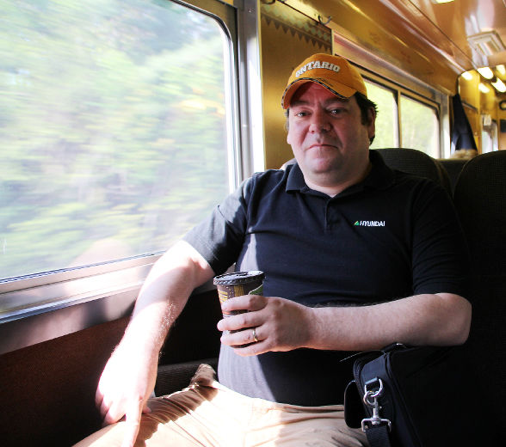
On November 30th, Linda Savory-Gordon from CAPT and I set out from Sault Ste. Marie for Wawa and Dubreuilville to attend meetings and to check out the CP Holiday Train event. We were excited to spend some time engaging with the municipalities and stakeholders in that area, and also show our support for CP rail and the potential connections that could be made at Franz with the CN line, upon reinstating the Algoma Passenger Train (Bear Train).
Somewhere around Batchewana Bay, we both began to notice a strange sound coming out of my car. It sounded a lot like flapping. We stopped and checked it out – and indeed, there was a piece of the underbelly of my car that was hanging a little loose. Since we still had service, we called an auto shop in Wawa to take a look when we got there. Otherwise, the damage seemed pretty surface and so we kept on, uneasy, but without many other options.
Things took quite the turn just 60km outside of Wawa, when the lug nuts on my left driver’s side tire snapped off and my wheel sunk into the fender of my car. Smoke clouded the air and sparks spewed out from the underbelly. We came to a stop, luckily still in the right lane, and took a look at the damage.
Now this would be a stressful and scary experience for any driver anywhere. But let’s consider some of the key points of this experience that, ironically, make it extremely relevant to my work here for the Missanabie Cree First Nation (MCFN) in renewing rail service in the north.
First and foremost, I had no cell service. I was wandering around, in shock, on hills and in the woods trying to get enough bars to call 911. When I did, the operator could hardly hear me, and it took twice as long to explain what had happened than it would if I had been in the city. Secondly, I had no real indication of where I was. I knew that we had passed Orphan Lake in Lake Superior Provincial Park, but aside from that, without any cellular data or signs nearby, it was nearly impossible to give the operator some kind of a landmark so that an OPP Officer could locate us.
Thirdly, once the reality of what had happened set in, I went into complete shock, shivering, shaking, and barely able to speak. If I had not been with Linda, or anyone, I am not sure how I would have been able to calm down or form words to any of the passersby who stopped, concerned. This shock and isolation would have been furthered by the inability to contact anyone from home on my phone. I ended up getting through to my dad and to my partner, but both had a very difficult time hearing me and in fact it only increased their worry – as they felt helpless to my situation.
Let us also consider the physical nature that we Northerners face, particularly on remote highways. Often times in poor weather conditions, like a white out, it is almost impossible to see ahead of you, thus putting you and anyone in front of you – whether they are stopped or not – in serious danger. If the weather was as we often do get it this time of year – freezing rain or blustery snowfalls – it would be extremely difficult and dangerous to be wandering outside of the car trying to find service or help.
Lucky for us, it was a pretty straight stretch of the highway, so as long as everyone was paying attention, and made a conscious effort to go around my car, we were likely to remain unharmed. Also in our fortune was the fact that the weather, while cold, was pretty clear, which lowered the chances of us or the car being hit while we waited for an officer and tow.
That brings me to the next major issue that anyone facing car troubles on a remote highway will face. After I finally got through to the operator, it took half an hour for him to get there. That was half an hour of my car on the highway across the lane at risk of further damage or of causing an accident. Once he arrived, and put his lights on behind me, I felt much more secure. After that though, it took another 45 minutes before a tow truck arrived. By this point, my teeth were chattering and I was literally shaking from head to toe. Nothing brought me more relief than hopping into the cab of the tow truck and heading towards Wawa, which was another 45 minutes after he arrived, as it was extremely difficult to get my damaged and fragile car onto the flatbed.
I got some really interesting insights from our tow truck driver on our drive in. Aside from telling us that he had never seen a car with the strange damage that mine had, he told us that, in high season in this area, he received 5 to 6 calls per day, most from tourists and students. Now, let’s take a minute to consider what that means for this demographic. Generally, students do not have a ton of disposable income to be spending on car repairs. Having to traverse this particular highway to attend school or to visit family is a huge stressor. The fact that there is no alternative route deters, and will continue to deter, students from up north attending post-secondary school in Sault Ste. Marie.
In terms of tourists, there are other stark realities that we as northerners need to address. To put it into perspective, I know that when I travel abroad or even to another part of Canada, I avoid driving at all costs. I don’t know the roads, I don’t know the area, I may not have cellular data or calling capabilities, and nothing about renting a vehicle or having to drive sounds even remotely appealing to me while I am travelling or on vacation. I would much rather rideshare or take a bus, train, or fly from location to location. Not only because it lowers my stress level, but it also allows me to really take in the local culture and landscapes. It also gives me a chance to gather my bearings. Whether it be through taking a much-needed nap or catching up on work from my laptop. As a tourist or traveller, these stolen moments are extremely important in getting the full experience of a country and optimizing your time.
Now, imagine tourists coming to visit our beautiful, remote landscapes, and realizing that one of their only options is to drive… to drive in a region they are unfamiliar with, potentially in a country they have never been to, in an area so remote that you could end up stranded with no municipality within an hour and a half driving distance in either direction? What I am saying is, how do we drive tourism to our region when we cannot even offer the methods of transportation to get to these destinations?
Maybe for some of you this sounds redundant, or difficult to relate to. I had trouble putting this all into words, but I really did think it was important to share, and hope that you all see – whether you support rail renewal or not – that we have inherent issues with our transportation and broadband systems in Northern Ontario, and my passion and dedication to help change this has only grown stronger.
I hope I have portrayed to you that this experience really impacted the way that I see my job and the work that MCFN is doing with stakeholders and municipalities to renew rail in the north. You really don’t realize how valuable something it is until you are in a situation where you need it. That is exactly what happened to me. I can’t stop thinking about how much worse it could have been, but I can tell you one thing for certain. After my experience, I would never opt to take my car up north for an overnight trip if passenger rail was an option.
Passenger rail service would change the fact of the north. It would lower the sheer number of accidents and tows and road construction needed. It would promote relaxing and leisurely tourism into the wooded wilderness. It would allow me to get to three meetings and one event successfully – and in fact, I would have been able to work on my laptop on the way over – without having to drop cash on car repairs.
Share your stories with me. E-mail Riley@BearTrain.ca.
Would you like to see the Mask-wa Oo-ta-ban, or "Bear Train," operating again between Sault Ste. Marie and Hearst?
Take the Bear Train Survey & Let Us Know


Stay Up to Date
Join our email list.
Join Newsletter
Thank you for signing up for our email list!
Please try again later.


